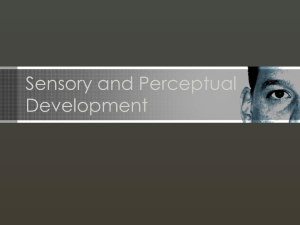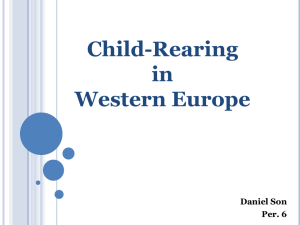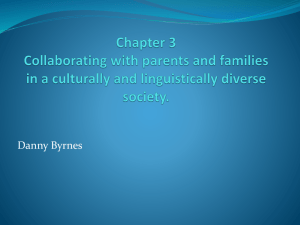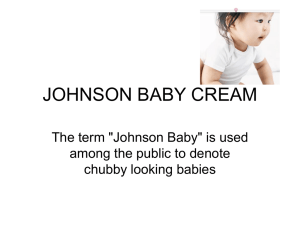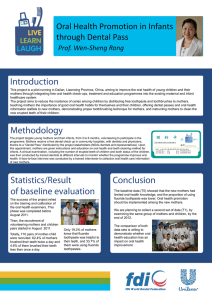Salem Magarian MD
advertisement
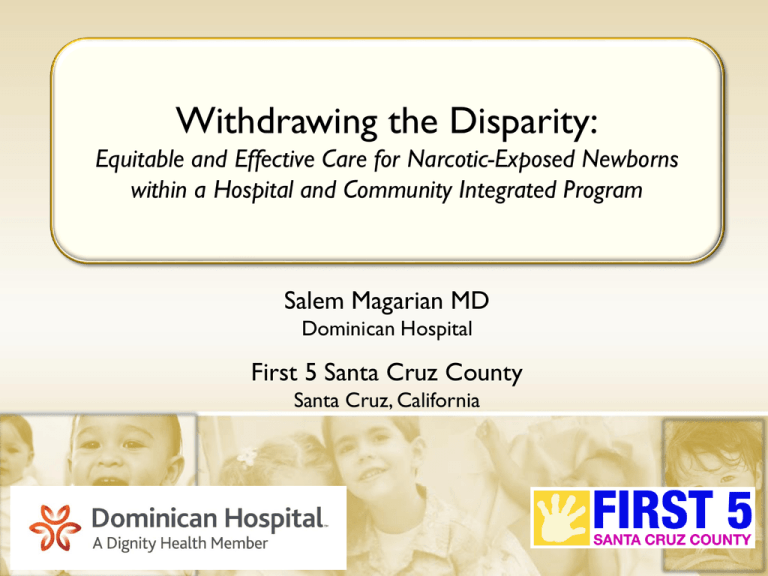
Withdrawing the Disparity: Equitable and Effective Care for Narcotic-Exposed Newborns within a Hospital and Community Integrated Program Salem Magarian MD Dominican Hospital First 5 Santa Cruz County Santa Cruz, California Building a Prenatal to Pediatric System of care for Narcotic Exposed Newborns Salem Magarian MD Dominican Hospital First 5 Santa Cruz County Santa Cruz, California Overview • Drug exposed babies experience differences in care and outcomes • There is huge long term cost to society • Professional prejudice and variable clinical approaches have provided only limited solutions • How can we create an organized system of care—in a real world with lean budgets and constricted staffing—to diminish or eliminate this disparity? 3 Prior Care for Drug-Exposed Newborns A decade ago, Santa Cruz County, California lacked a consistent approach to the care of infants exposed in utero to drugs of abuse. Several problems were apparent: • Mothers sought to hide their drug problem • There were avoidable neonatal complications from the lack of prenatal care and lack of prior identification for drug-exposed newborns • Initial hospital stays were prolonged because of largely avoidable or reducible medical conditions for both the mothers and infants • There were no clear goals for medical treatment of these infants, no clear medical practice standards of care, and variable Child Protective Services practices 4 Disparity of Care for Drug-Exposed Newborns Several problems were apparent (continued): • Prejudice toward this population existed within many corners of the medical provider community • No standard pharmacologic treatment of withdrawal symptoms • Babies received inconsistent medical follow-up by providers knowledgeable about this condition • Many out-patient pharmacy errors • Child Protective Services, the judicial system, and foster care had poor integration with prenatal and pediatric care 5 Patterns of Prenatal and Hospital Care Most of these babies: • Had little prenatal care • Were not identified prior to delivery • Had significant risk for adverse perinatal outcomes • Had challenging psycho-social and custody issues during the hospital stay • Had prolonged NICU stays 6 Patterns of Follow-Up Pediatric Care The medical, social, and neurodevelopmental costs were enormous Most of these babies: • Were discharged into highly variable medical and placement situations • Experienced multiple ER visits and re-hospitalization • Had escalating Child Protective Service involvement • Had a high probability of foster care placement • Had a high risk for future poor neurodevelopment outcomes 7 Long-Term Societal Costs Increases in all of the following: • Medical utilization • Child protective service intervention • Foster care • Developmental and behavioral disabilities • Special educational interventions • Juvenile and adult criminal justice involvement • Generational recidivism • Lost workplace productivity 8 Sneak Preview of The Results The “word on the street” for drug-abusing pregnant mothers quickly changed to an understanding that this program is the path to recovery and keeping your baby Average initial NICU stay was reduced from 14 to 9 days (35% reduction) ER visits and re-hospitalization have been essentially eliminated Most mothers nurse their infants, retain custody, and continue in recovery The majority of infants appeared normal on developmental screening Mothers ask to be in this program 9 Importance of Intervention The financial value to society of quality investment in early children programs is no longer speculation “There is an extensive, and rapidly expanding, amount of scientific evidence illustrating the extent to which early experiences affect the biology of the body, becoming embedded in the development of multiple organ systems. As a result, the consequences of adversity early in life can be serious and longlasting, affecting the body’s ability to, for example, regulate metabolism, fight disease, and maintain a healthy heart—as well as a healthy brain. Reducing toxic stress in early childhood is therefore an important strategy for lifelong health promotion and disease prevention.” - Dr. Jack Shonkoff of Harvard’s Center for the Developing Child 10 Importance of Intervention “A major refocus of policy is required to understand the life cycle of skill and health formation and the importance of the early years in creating inequality in America. All capabilities are built on a foundation of capacities that are developed earlier…. Early intervention lowers the cost of later investment.” - Nobel Prize winning economist Dr. James Heckman 11 Benefits of Early Intervention Decreasing the disparity of care for drug-exposed infants would result in: • Individual benefits • Improved neurodevelopmental outcomes • Increased personal productivity • Greater educational and professional achievements • Systems benefits Financial savings in: • • • • • Medical systems Child welfare systems Educational systems Juvenile and adult justice systems Adult welfare programs 12 Building the Team • The early team consisted of a pediatrician, a NICU nurse, a social worker, and a public health nurse, and quickly included key individuals from the child welfare system • Dominican Hospital offered its safety net pediatric clinic as the medical home for all of these drug-exposed babies • The County Health Department contributed public health nursing and training for providers, coordinating with drug rehabilitation programs starting in pregnancy • The County’s First 5 program funded “Families Together,” a program to provide support and coaches for high-risk families with CPS allegations but not leading to foster placement. 13 The Goals Develop a uniform “clinical pathway” for the care of the drug exposed infant from prenatal to pediatric care. The goals seemed simple but ambitious: 1. Minimize in-patient bed days and ER use 2. Minimize time that infants suffer drug withdrawal symptoms 3. Keep babies with their biologic mothers, if safe, and minimize the number of transitions to new caregivers 4. Infants demonstrate normal growth and development 5. Normal long-term neurodevelopment and child mental health 14 Program Changes: Prenatal All pregnant mothers using drugs of abuse and methadone were offered drug rehabilitation services. All mothers with heroin and narcotic issues were offered methadone treatment. Prenatal care was concentrated with one obstetrical group. All mothers were seen by a MCH social worker prior to delivering. 15 Program Changes: Newborn Period All babies were cared for in the NICU and received a standardized neonatal withdrawal treatment until withdrawal symptoms were controlled. All mothers and babies were seen by the MCH social worker on the first day of life and CPS was notified of the birth. Placement decisions were made by CPS early in the hospital stay. All mothers were encouraged and professionally supported to breast feed unless there was a specific medical contraindication. All babies were seen by a pediatric occupational therapist. Infants were discharged when they were medically stable, feeding well, with withdrawal symptoms controlled for 48 hours. 16 Newborn Clinical Pathway All babies cared for in NICU. Neonatal abstinence scoring (NAS) every two hours. Replacement morphine started early at standardized threshold. Increased morphine every eight hours until NAS scores normalized. Phenobarbital added only if maximum morphine dose was reached. Infants were discharged when they were medically stable, feeding well, with withdrawal symptoms controlled for 48 hours. 17 Newborn Clinical Pathway: Medication Neonatal abstinence scoring (NAS) every two hours. (Finnegan score) Replacement morphine started early when NAS > 8. All morphine same concentration .4 mg / ml Starting dose = .2 mg for all term babies (no weight adjustment) Increase morphine .1 ml =.04 mg every eight hours until NAS scores normalized up to .4-.5 mg morphine. Phenobarbital added only if maximum morphine dose was reached with NAS still > 8 Phenobarb started at 5 mg/ kg / day without loading dose. Infants were discharged when they were medically stable, feeding well, with withdrawal symptoms controlled for 48 hours. 18 Program Changes: Pediatrics Infants were seen the day after discharge in one clinical site, the Dominican Pediatric Clinic, and then weekly. All prescriptions from only one pharmacy 2 week supply Weekly visits for the first two months The babies were weaned from medication following set guidelines. Narcotic replacement medication given by all mothers Standardized developmental screening ASQ 9 and 24 months MCHAT at 18 months All babies were seen by one year of age by the Stanford High-Risk Infant Follow-up clinic for detailed neuro-developmental assessment. 19 Pediatrics Clinical Pathway Weekly Clinic visits by same provider: Evaluate weight gain, feeding, neurologic status, parents’ compliance with recovery program. Evaluate parenting capacity, mental health, and compliance with support services Concurrent visits with occupational therapist for issues of state regulation and feeding. 20 Pediatrics Clinical Pathway Medication Weaning No medication changes until one month of age. Gradual wean of morphine over second month of life Decrease morphine .1 ml = .04 mg every 3 days Slow taper only if infant becomes re-symptomatic If on phenobarb: When morphine dosage decreased by 50%, cut phenobarb dose in half. DC phenobarb one week later. 21 The Results The “word on the street” for drug-abusing pregnant mothers quickly changed to an understanding that this program is the path to recovery and keeping your baby Average initial NICU stay was reduced from 14 to 9 days ER visits and re-hospitalization have been essentially eliminated Most mothers nurse their infants, retain custody, and continue in recovery The majority of infants appeared normal on developmental screening Mothers ask to be in this program 22 The Long Term Future Savings • Hospital costs savings • Health plan savings • Follow-Up Early intervention saving • School system special services saving • Juvenile justice saving • Adult criminal justice / incarceration savings • Increased long term work productivity • Decreased inter-generational recidivism 23 Summary • This was a spontaneously evolving hospital and community-based care path that addressed significant disparities in care for drug exposed newborns. • The outcome was medical care cost savings, less foster care placement, improved infant health, better maternal attachment, and long term healthy neurodevelopment. “The short term financial savings [of this program]—even without the projected long term savings to society—would make a compelling case for adoption. The enhancement of human quality of life is not quantitatively measurable, but intuitively substantial. … This is exactly the kind of direct, adaptive, clinical team learning—driven by a patient centered mission and fueled by community partnerships—that QI leaders crave for a reforming health care system” - Dr. Wells Shoemaker 24 Contact Me Salem Magarian MD • Medical Director, Dominican Pediatric Clinic Dominican Hospital Santa Cruz, CA 95065 • Phone: (831) 457-7038 • Email: Salem.Magarian@DignityHealth.org 25
